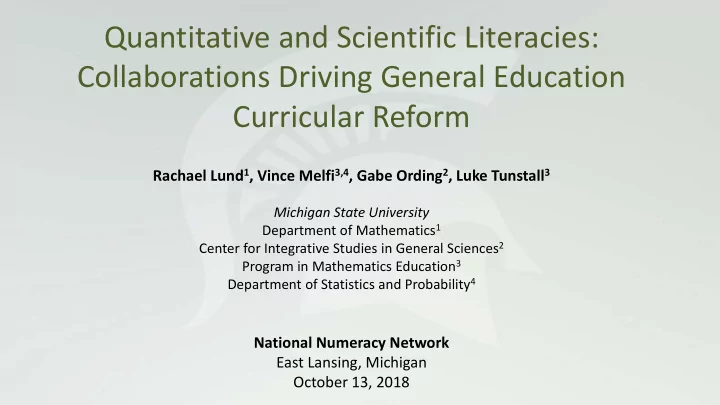

Quantitative and Scientific Literacies: Collaborations Driving General Education Curricular Reform Rachael Lund 1 , Vince Melfi 3,4 , Gabe Ording 2 , Luke Tunstall 3 Michigan State University Department of Mathematics 1 Center for Integrative Studies in General Sciences 2 Program in Mathematics Education 3 Department of Statistics and Probability 4 National Numeracy Network East Lansing, Michigan October 13, 2018
Show of Hands!!! Does your institution offer a Quantitative Literacy (QL) course? Do you teach a QL course? Do QL (or mathematics) and science faculty collaborate on curricular development and assessment?
Institutional Landscape General Education at MSU concentrated in three sets of Integrative Studies course requirements Science General S cience Arts and Humanities Social Science Writing S ocial Arts and Quantitative Literacy/Mathematics requirement S cience Humanities
Institutional Landscape The University mathematics graduation requirement may be met via two courses from Mathematics or Statistics including two newly created QL courses (MTH 101 and 102) Students no longer place into developmental mathematics
Big Bureaucracy and Big Numbers Changes to graduation requirements and QL courses are recent, build on over ten years of work, and needed buy-in at many levels. QL courses are taken almost exclusively by non-STEM majors N=1200 in MTH 101 N=1000 in MTH 102
Opportunities for Collaboration The majority of non-STEM students enroll in both QL (MTH 101) and Integrative Studies in Science courses (ISB and ISP) Integrative Science redesign informed and affected by reform in quantitative graduation requirement and development of QL-focused courses
CISGS Vision for Change CISGS 300 (3 cr.) Scientific Literacy Quantitative Literacy CISGS 300 Learning Outcomes (In Development) CISGS Lab (2 cr.) Scientific Literacy Quantitative Literacy CISGS 200 (3 cr.) MTH 101 Pre Requisite Scientific Literacy Information Literacy Information Literacy CISGS Lab Goals CISGS 200 Learning Outcomes Engage in Scientific Practice (In Development) Capture Raw Data Conduct Data Analysis Effective Communication
CISGS Faculty Survey Scientific Literacy? (n=36 Response Rate=68%) Attitudes Knowledge Skills Nature of Science/Scientific Process Valuation: Process of Science (34) Quantitative Literacy (28) (25) Science & Understanding (17) Information Literacy (21) Specific Content Knowledge (15) Openness & Cultural Awareness (11) Evidence-based Argumentation & Evolution (14) Science & Decision Making (10) Decision-making (18) Energy & Matter (13) Curiosity / Awareness / Interest (5) Recognize Science and Non-science Society & Population (11) Skepticism (4) (13) Universe (9) Science & Society (4) Other (13) Environment & Climate Change (9) Other (12) Communication (12) Cycles & Flows (7) Process of Science (11) Other (7) Modelling (8) Quantitative Literacy (6) Reading & Comprehension (4) Ecology/Ecosystems (4) Empathy (2) Hierarchy & Scale (4) Physical & Chemical Properties (3)
Partnership in Action Bring cross disciplinary faculty teams together Collaboratively identify essential student outcomes Consensus on skills, context, and language Collaboratively embed assessment across disciplines
Examples Include New topics in MTH 101 this semester Excel Visual Representation of Data Dimensional Analysis ISP 203 Lab Students Biomonitoring Red Cedar River Common assessment topics in Final Exams Common pre/post survey (SALG)
Assessment Efforts in Science To what ends? Modify QL courses, and/or demonstrate their efficacy in improving lab outcomes Better understand transfer across courses and semesters Current efforts (Fall 2018) Four ISB/ISP lab programs will have a common embedded assessment in the final exam (n=1700+ students) Four lecture courses will have common embedded assessments (n=600+ students)
Assessment—Looking Ahead General education science courses can be vehicles for improving QL (Follette et al., 2015) To what extent are they doing that? QuaRCS How are students' QL and SL manifesting in upper-level courses in the major? Collaboration with departments like Journalism, Communication, and Advertising, among others Opportunities for more interdisciplinary research that accounts for research from psychology and the decision sciences (e.g., Kahan, Peters, Dawson, & Slovic, 2017)
Partnership Discussion In one sentence, describe the goal(s) of your QL course. Do QL (or mathematics) and science faculty collaborate on introductory courses? Who is driving the reform? Department? Dean? Provost? How are faculty incentivized to participate? Course release? Time buy out? Summer salary? Part of their job description? Do you have concrete deliverables in a concrete timeline ?
Assessment Discussion Do you or colleagues assess students' QL or SL outside of routine course assessments? What ideas do you have for accounting (in assessments) for the complexity of QL and SL "in the wild"? What would an ideal assessment plan look like at an institution where QL and SL are major goals of undergraduate education?
Common Intellectual Experience (CIE) Pilot (AY 17-18) Student Success Initiative First-Semester Cohort Experience Collaboratively develop and deliver required Science and Math classes Common Theme - Social Justice “Can it be expanded?!?!” Full First-Year Other Integrative Studies Centers First Year Writing Cocurricular experiences Neighborhood Success Centers Graduate Student Mentors E-portfolios
Common Intellectual Experience (CIE) Success to Report CIE Non CIE CIE students had a Students Students .40 higher average MTH 101 grade, Average Math 9.5 12.5 despite having a Placement Score lower MSU math placement Average Math 101 3.37 2.97 score. Grade Data Analysis Conducted by Dr. Justin Bruner (ISS / APUE)
Quantitative and Scientific Literacies: Collaborations Driving General Education Curricular Reform Rachael Lund 1 , Vince Melfi 3,4 , Gabe Ording 2 , Luke Tunstall 3 Michigan State University Department of Mathematics 1 Center for Integrative Studies in General Sciences 2 Program in Mathematics Education 3 Department of Statistics and Probability 4 National Numeracy Network East Lansing, Michigan October 13, 2018
Recommend
More recommend